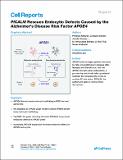PICALM Rescues Endocytic Defects Caused by the Alzheimer’s Disease Risk Factor APOE4
Author(s)
Narayan, Priyanka; Sienski, Grzegorz; Bonner, Julia M; Lin, Yuan-Ta; Seo, Jinsoo; Baru, Valeriya; Haque, Aftabul; Milo, Blerta; Akay, Leyla A; Graziosi, Agnese; Freyzon, Yelena; Landgraf, Dirk; Hesse, William R; Valastyan, Julie; Barrasa, M Inmaculada; Tsai, Li-Huei; Lindquist, Susan; ... Show more Show less
DownloadPublished version (2.630Mb)
Publisher with Creative Commons License
Publisher with Creative Commons License
Creative Commons Attribution
Terms of use
Metadata
Show full item recordAbstract
The ε4 allele of apolipoprotein E (APOE4) is a genetic risk factor for many diseases, including late-onset Alzheimer's disease (AD). We investigate the cellular consequences of APOE4 in human iPSC-derived astrocytes, observing an endocytic defect in APOE4 astrocytes compared with their isogenic APOE3 counterparts. Given the evolutionarily conserved nature of endocytosis, we built a yeast model to identify genetic modifiers of the endocytic defect associated with APOE4. In yeast, only the expression of APOE4 results in dose-dependent defects in both endocytosis and growth. We discover that increasing expression of the early endocytic adaptor protein Yap1802p, a homolog of the human AD risk factor PICALM, rescues the APOE4-induced endocytic defect. In iPSC-derived human astrocytes, increasing expression of PICALM similarly reverses endocytic disruptions. Our work identifies a functional interaction between two AD genetic risk factors—APOE4 and PICALM—centered on the conserved biological process of endocytosis.
Date issued
2020Department
Whitehead Institute for Biomedical Research; Picower Institute for Learning and Memory; Massachusetts Institute of Technology. Department of Brain and Cognitive Sciences; Massachusetts Institute of Technology. Department of Biology; Howard Hughes Medical InstituteJournal
Cell Reports
Publisher
Elsevier BV